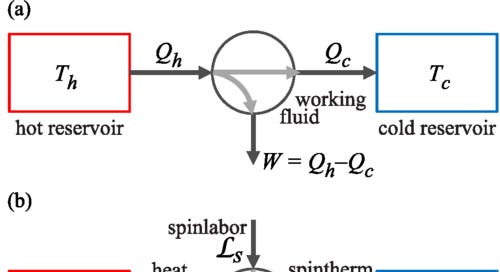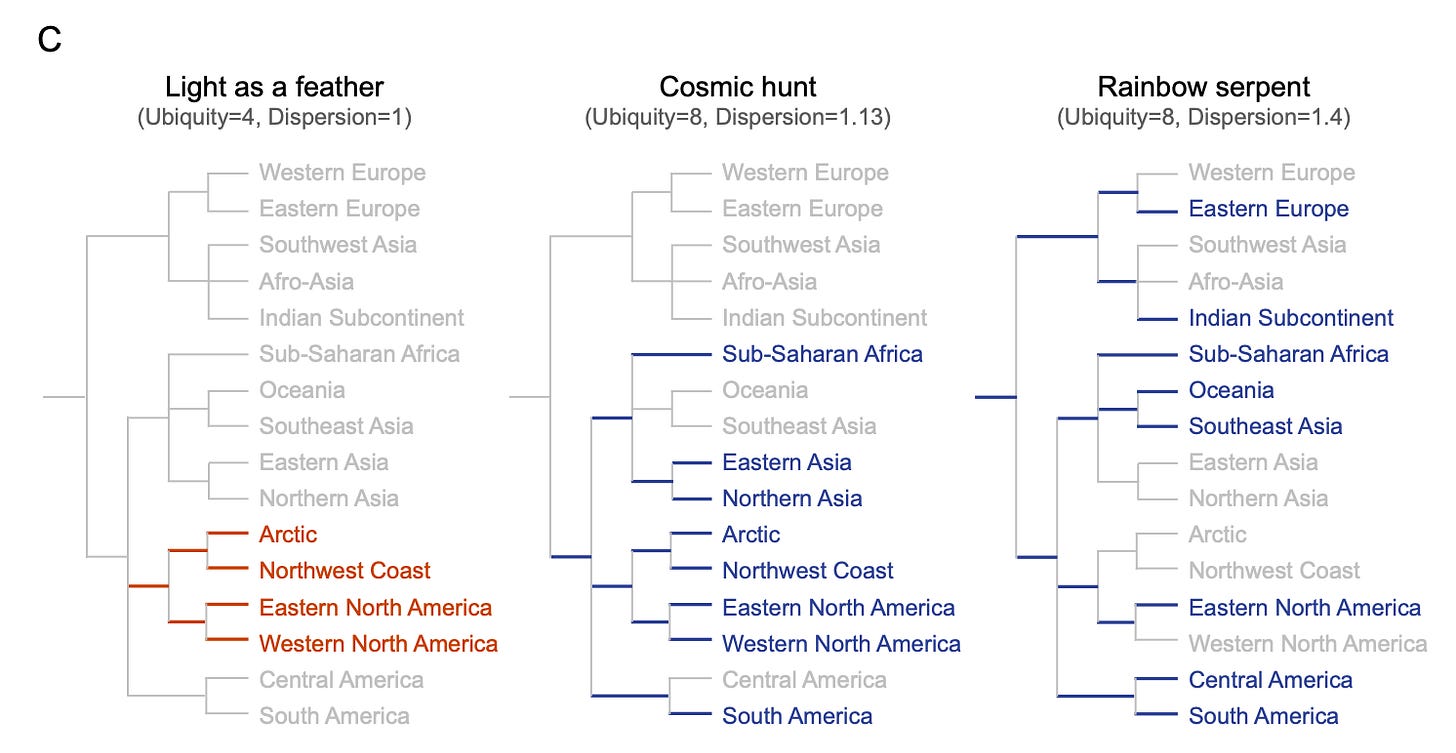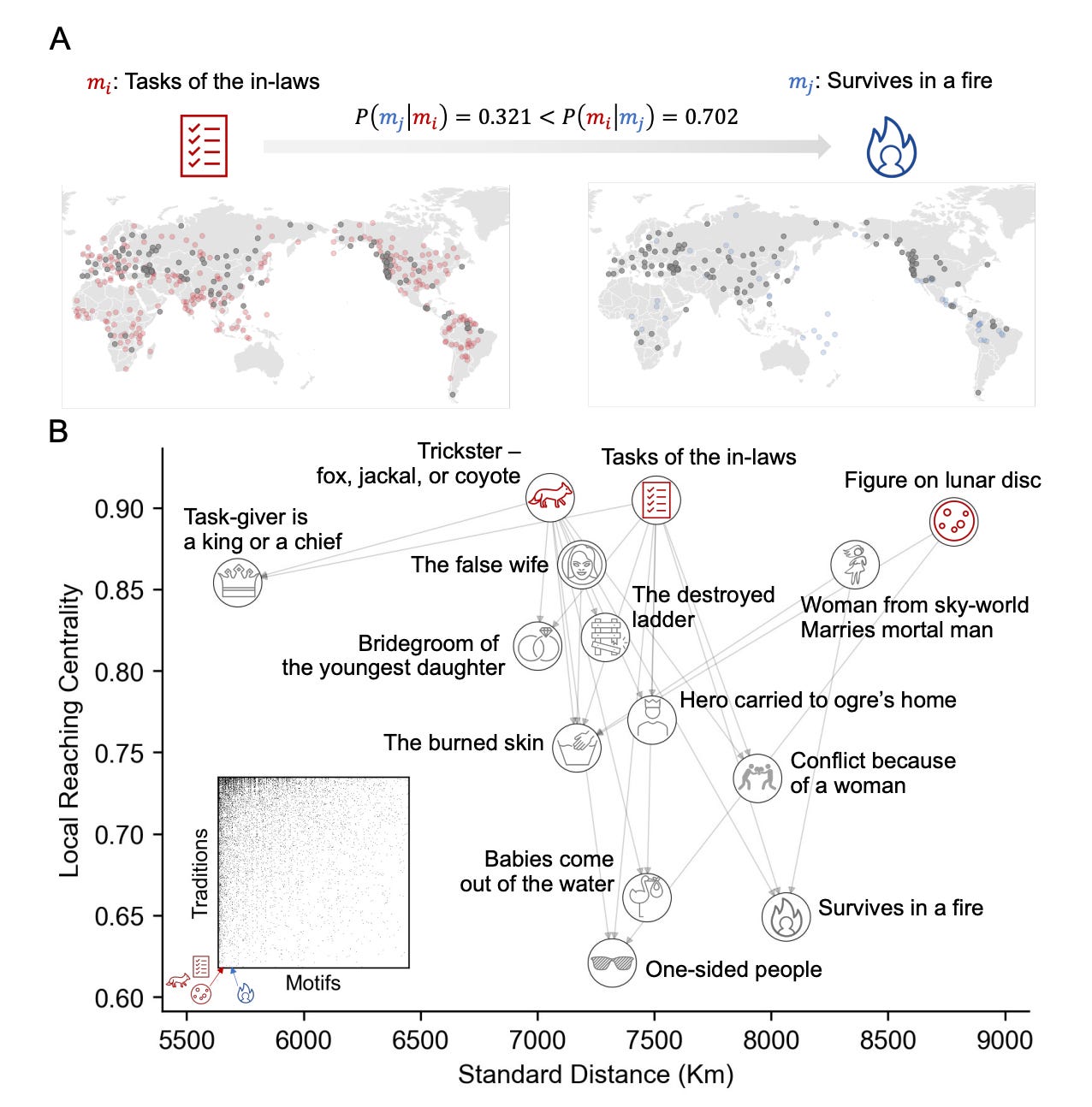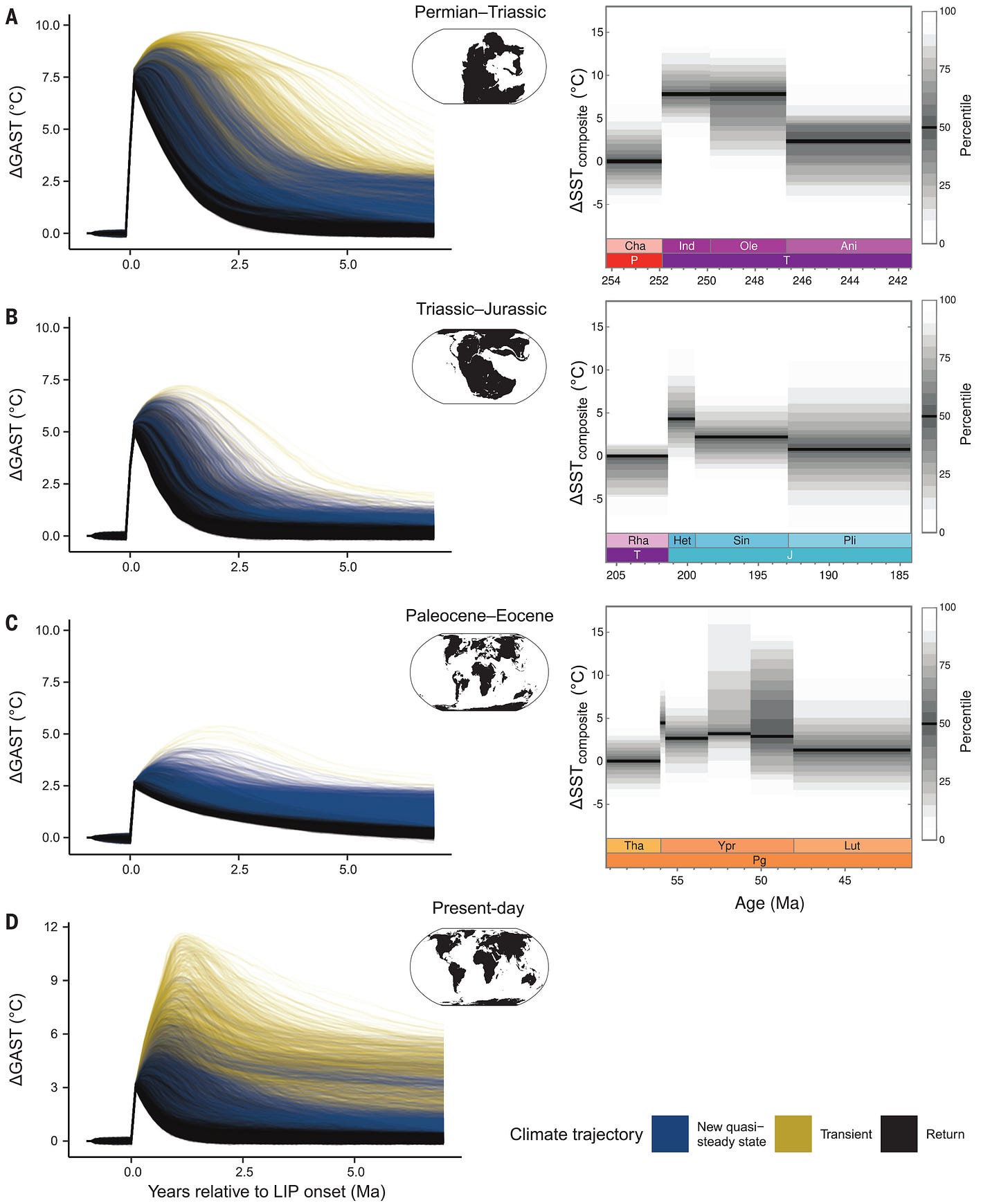If you find Complexity Thoughts interesting, follow us! Click on the Like button, leave a comment, repost on Substack or share this post. It is the only feedback I can have for this free service. The frequency and quality of this newsletter relies on social interactions. Thank you!
Foundations of network science and complex systems
Noise-Induced Network Topologies
We analyze transport on a graph with multiple constraints and where the weight of the edges connecting the nodes is a dynamical variable. The network dynamics results from the interplay between a nonlinear function of the flow, dissipation, and Gaussian, additive noise. For a given set of parameters and finite noise amplitudes, the network self-organizes into one of several metastable configurations, according to a probability distribution that depends on the noise amplitude 𝛼. At a finite value 𝛼, we find a resonant-like behavior for which one network topology is the most probable stationary state. This specific topology maximizes the robustness and transport efficiency, it is reached with the maximal convergence rate, and it is not found by the noiseless dynamics. We argue that this behavior is a manifestation of noise-induced resonances in network self-organization. Our findings show that stochastic dynamics can boost transport on a nonlinear network and, further, suggest a change of paradigm about the role of noise in optimization algorithms.
A tape-reading molecular ratchet
This would be a machine function related to ribosomal transcription in a wholly synthetic molecular system, carried out in a manner reminiscent of Turing’s original description1 of an automatic machine capable of arbitrary computations.
Cells process information in a manner reminiscent of a Turing machine1, autonomously reading data from molecular tapes and translating it into outputs2,3. Randomly processive macrocyclic catalysts that can derivatise threaded polymers have been described4,5, as have rotaxanes that transfer building blocks in sequence from a molecular strand to a growing oligomer6,7,8,9,10. However, synthetic small-molecule machines that can read and/or write information stored on artificial molecular tapes remain elusive11,12,13. Here we report on a molecular ratchet in which a crown ether (the ‘reading head’) is pumped from solution onto an encoded molecular strand (the ‘tape’) by a pulse14,15 of chemical fuel16. Further fuel pulses transport the macrocycle through a series of compartments of the tape via an energy ratchet14,17,18,19,20,21,22 mechanism, before releasing it back to bulk off the other end of the strand. During its directional transport, the crown ether changes conformation according to the stereochemistry of binding sites along the way. This allows the sequence of stereochemical information programmed into the tape to be read out as a string of digits in a non-destructive manner through a changing circular dichroism response. The concept is exemplified by the reading of molecular tapes with strings of balanced ternary digits (‘trits’23), −1,0,+1 and −1,0,−1. The small-molecule ratchet is a finite-state automaton: a special case24 of a Turing machine that moves in one direction through a string-encoded state sequence, giving outputs dependent on the occupied machine state25,26. It opens the way for the reading—and ultimately writing—of information using the powered directional movement of artificial nanomachines along molecular tapes.
Quantum heat engine operating between thermal and spin reservoirs
Landauer's erasure principle is a cornerstone of thermodynamics and information theory [R. Landauer, IBM J. Res. Dev. 5, 183 (1961)]. According to this principle, erasing information incurs a minimum energy cost. Recently, Vaccaro and Barnett [J. A. Vaccaro and S. M. Barnett, Proc. R. Soc. A 467, 1770 (2011)] explored information erasure in the context of multiple conserved quantities and showed that the erasure cost can be solely in terms of spin angular momentum. As Landauer's erasure principle plays a fundamental role in heat engines, their result considerably widens the possible configurations that heat engines can have. Motivated by this, we propose here an optical heat engine that operates under a single thermal reservoir and a spin angular momentum reservoir coupled to a three-level system with two energy degenerate ground states. The proposed heat engine operates without producing waste heat and goes beyond the traditional Carnot engine where the working fluid is subjected to two thermal baths at different temperatures.
Evolution
Extreme mitochondrial reduction in a novel group of free-living metamonads
Mitochondria are usually understood as essential biological units for energy production in cells, acting as the “powerhouses” that convert nutrients into ATP (the molecule that fuels most cellular processes). They also play a key role in regulating cell growth, metabolism, and even programmed cell death, making them vital for overall cell function and health.
This paper is interesting, because it somehow challenges this view, showing that mitochondria can be degraded after being donated by one cell to another, a process that leads to new mitochondria formation. So, in specific biological contexts such as during blood vessel formation, mitochondria are not just central powerhouses but can be “expendable” and replaced through some cellular mechanisms.
Therefore mitochondria are not irreplaceable and play a dynamic role beyond just energy production, particularly in regeneration and cellular adaptation.
Metamonads are a diverse group of heterotrophic microbial eukaryotes adapted to living in hypoxic environments. All metamonads but one harbour metabolically altered ‘mitochondrion-related organelles’ (MROs) with reduced functions, however the degree of reduction varies. Here, we generate high-quality draft genomes, transcriptomes, and predicted proteomes for five recently discovered free-living metamonads. Phylogenomic analyses placed these organisms in a group we name the ‘BaSk’ (Barthelonids+Skoliomonads) clade, a deeply branching sister group to the Fornicata, a phylum that includes parasitic and free-living flagellates. Bioinformatic analyses of gene models shows that these organisms are predicted to have extremely reduced MRO proteomes in comparison to other free-living metamonads. Loss of the mitochondrial iron-sulfur cluster assembly system in some organisms in this group appears to be linked to the acquisition in their common ancestral lineage of a SUF-like minimal system Fe/S cluster pathway by lateral gene transfer. One of the isolates, Skoliomonas litria, appears to have lost all other known MRO pathways. No proteins were confidently assigned to the predicted MRO proteome of this organism suggesting that the organelle has been lost. The extreme mitochondrial reduction observed within this free-living anaerobic protistan clade demonstrates that mitochondrial functions may be completely lost even in free-living organisms.
Neuroscience
Chromatin plasticity predetermines neuronal eligibility for memory trace formation
It's known that not all neurons in a given region are equally likely to become part of a memory trace. Neurons that are more excitable and those that are active at critical times during a memory-forming event are more likely to be recruited into the engram (the neural basis of a memory). This selective recruitment is essential for the efficient storage and retrieval of memories, ensuring that only key information relevant to the memory is encoded. But how that selection happens?
neuron’s epigenetic makeup defines its eligibility to be selected for storing learned information
Memories are encoded by sparse populations of neurons but how such sparsity arises remains largely unknown. We found that a neuron’s eligibility to be recruited into the memory trace depends on its epigenetic state prior to encoding. Principal neurons in the mouse lateral amygdala display intrinsic chromatin plasticity, which when experimentally elevated favors neuronal allocation into the encoding ensemble. Such chromatin plasticity occurred at genomic regions underlying synaptic plasticity and was accompanied by increased neuronal excitability in single neurons in real time. Lastly, optogenetic silencing of the epigenetically altered neurons prevented memory expression, revealing a cell-autonomous relationship between chromatin plasticity and memory trace formation. These results identify the epigenetic state of a neuron as a key factor enabling information encoding.
Human behavior
Deeply nested structure of mythological traditions worldwide
Usually I go through pre-prints as well, but I share here mostly published papers (ie, after peer-review). There are exceptions, though.
I really wondered how some narratives related to myths and cultural transmission are related with each other. Finally, there is a paper about this!
All human societies present unique narratives that shape their customs and beliefs. Despite cultural differences, some symbolic elements (e.g., heroes and tricksters) are common across many cultures. Here, we reconcile these seemingly contradictory aspects by analyzing mythological themes and traditions at various scales. Our analysis revealed that global mythologies exhibit both geographic and thematic nesting across different scales, manifesting in a layered structure. The largest geographic clusters correspond to the New and Old Worlds, which further divide into smaller bioregions. This hierarchical manifestation closely aligns with historical human migration patterns at a large scale, suggesting that narrative themes were carried through deep history. At smaller scales, the correspondence with bioregions indicates that these themes are locally adapted and diffused into variations across cultures over time. Our approach, which treats myths and traditions as random variables without considering factors like geography, history, or story lineage, suggests that the manifestation of mythology has been well-preserved over time and thus opens exciting research avenues to reconstruct historical patterns and provide insight into human cultural narratives.
Climate and Earth systems
Did you ever hear about eco-evolutionary vegetation dynamics? It refers to the intertwined processes where ecological interactions and evolutionary changes influence each other in plant communities. In these systems, the ecological outcomes, such as species composition and competition, can drive evolutionary adaptations, which in turn affect ecological dynamics (a great example of feedback loop!). For example, as plants evolve traits to better compete for resources, these new traits can alter the ecosystem’s structure and function, leading to further ecological changes.
This interdependency is a of high interest for ecologists and understanding this dynamics, and how it affects ecological communities, is a central topic in theoretical ecology (we are working on this matter, together with two great groups in Israel and the UK). This feedback loop between evolution and ecology is relevant for understanding how vegetation responds to environmental pressures, such as climate change, and manages resilience and adaptation over time.
Their reconstructions of the Permian-Triassic, Triassic-Jurassic, and Paleocene-Eocene global warming events illustrate how the dynamics of the living biosphere shape the Earth system’s response to sudden major degassing and global warming episodes over millions of years.
Periods of large igneous province (LIP) magmatism have shaped Earth’s biological and climatic history, causing major climatic shifts and biological reorganizations. The vegetation response to LIP-induced perturbations may affect the efficiency of the carbon-climate regulation system and the post-LIP climate evolution. Using an eco-evolutionary vegetation model, we demonstrate here that the vegetation’s climate adaptation capacity, through biological evolution and geographic dispersal, is a major determinant of the severity and longevity of LIP-induced hyperthermals and can promote the emergence of a new climatic steady state. Proxy-based temperature reconstructions of the Permian-Triassic, Triassic-Jurassic, and Paleocene-Eocene hyperthermals match the modeled trajectories of bioclimatic disturbance and recovery. We conclude that biological vegetation dynamics shape the multimillion-year Earth system response to sudden carbon degassing and global warming episodes.
Oldies but goldies
Self-Organisation in Nonequilibrium Systems: Towards A Dynamics of Complexity
by I. Prigogine & G. Nicolis
Complex behaviour made its appearance in the physical sciences in a modest, low-key fashion. For a long time, in the mind of most physicists and chemists, complexity was associated with biological order and its multiple manifestations, for example at the level of evolution, embryogenesis and population dynamics. Physical sciences on the other side were aiming at a description of nature in terms of laws of universal validity. And to this end they were utilising simple models to which, hopefully, the description of more complicated systems could be reduced. This feeling has been repreatedly expressed by some of the greatest scientists of our century. Thus, for Einstein “the physicist must content himself with describing the most simple events which can be brought within the domain of our experience; all events of a more complex order are beyond the power of the human intellect to reconstruct with the subtle accuracy and logical perfection which the theoretical physicist demands …. The general laws on which the structure of theoretical physics is based claim to be valid for any natural phenomenon whatsoever.









